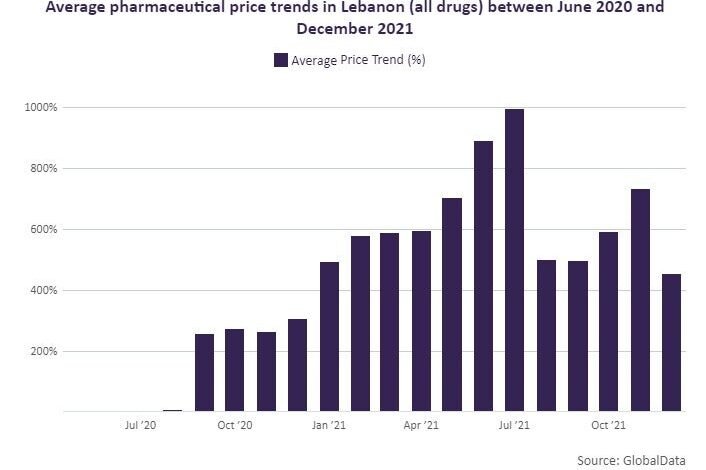Economic unrest results in an average pharmaceutical price trend of 1,123% in Lebanon

Lebanon’s ongoing economic crisis and changes in pricing strategies have caused monumental price hikes that impact market access. In Lebanon, the battle for access to medicines rages on and is further heightened by dramatic decreases in the healthcare budget last year. Consequentially, the five-year average price trend in Lebanon for all medicines has increased to 1,123%. GlobalData reviews the key events leading up to these current price trends in Lebanon.
Lebanon’s P&R system
In Lebanon, drug prices are reviewed and determined by the Ministry of Public Health (MoPH) during the registration process. International reference pricing applies to all originator medicines and serves as the main mechanism for pricing in-patent and off-patent originator drugs. Locally manufactured drugs are priced according to a Ministry of Industry evaluation and a final decision is delivered by a pricing committee composed of the Ministry of Economy and Trade and the Ministry of Industry, while locally made generics are priced at a fixed percentage less than the originator. Reimbursement for these prices is covered either through public health insurance, public reimbursement, or private insurance in Lebanon.
An average 236% price increase occurred in Lebanon between 2017-2021
Signs of sharp price increases at the manufacturer level started back in 2021 due to the removal of state subsidies on many products. The reduction in subsidies was expected with the non-improving economic crisis.
Manufacturer prices in Lebanon, therefore, saw an average 236% price increase between 2017 and 2021 across all drug types while other countries in the Middle East remained relatively stable in comparison or even decreased.
Additionally, Lebanon relies on foreign currency for 80% of drugs. The strategy of cutting subsidies for generics while maintaining subsidies for expensive drugs is questionable, as a switch to generics when available can theoretically help achieve cost containment, particularly in the Lebanese market, which is dominated by branded pharmaceuticals. Branded medicines accounted for roughly 76% of the Lebanese market in 2022, according to GlobalData’s Price Intelligence (POLI) database. While Lebanon has the third greatest generic market penetration of the Middle East (24.5%), it is still yet to match the average generic penetration seen in Europe (42%) and North America (51%), which are roughly double that of Lebanon.
2022 sees problems exacerbated by decreased budget
In 2022, the monthly healthcare budget for Lebanon underwent a dramatic decrease from $120m to $35m. A consequence of this steep alteration in the budget was the price reform that followed in May. The Ministry of Health’s (MoH) new pricing strategies would free up funds to import expensive cancer treatments and maintain their availability on the market. Prices of these cancer drugs would be routinely compared for the same active pharmaceutical ingredient (API) so that only the cheapest drug was publicly subsidised. This served as a paradigm shift by placing focus on generics in the brand-conscious Lebanese market. However, the economic crisis in Lebanon has made cancer drugs difficult for patients to obtain or even unavailable. Ways of obtaining these drugs include imports from Turkey and Syria or via the black market. Prices ranged from $800 to $7,000 and were likely even higher if bought on the black market.
Further subsidy reductions and weakening Lebanese pound
Recently (December 2022) a sharp fall in the value of the Lebanese pound to the US dollar led to an also sharp increase in the price of goods. Based on the further deteriorating economic situation, the MoH provided a pricing resolution that reduced subsidies on a range of raw materials used for local production and packaging of medicines. It is particularly detrimental for drugs priced up to L£399,000 ($279.30), which thereby saw their subsidy reduced from 100% to 40%, and which account for the majority (70%) of drugs manufactured in Lebanon. As this reduction of subsidies coincided with the weakening of the Lebanese pound, it resulted in further heavy price increases. The astounding impact on Lebanese drug prices means medicines received on average a 1,123% price increase between 2018–2022. This is a price jump of an additional 887% compared to between 2017–2021.
The ongoing economic crisis matched with depreciating currency, reliance on foreign currency for drugs, reduction in subsidies, and severely reduced healthcare budget have all impacted drug prices in Lebanon. Consequently, the current five-year average (2019–2022) suggests Lebanon will see the greatest price hikes of any Middle Eastern country and is unlikely to improve soon.
Source link
#Economic #unrest #results #average #pharmaceutical #price #trend #Lebanon